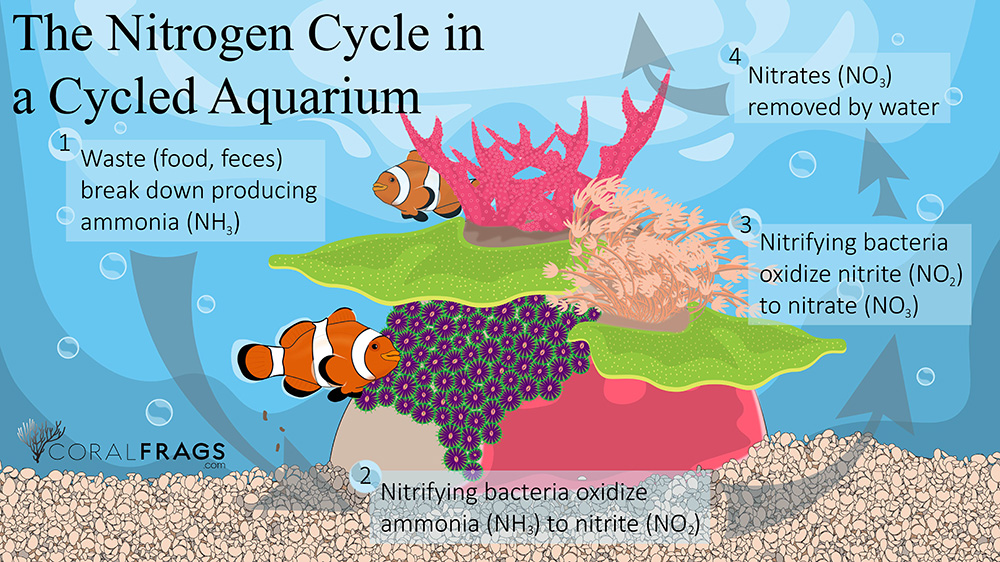What do We Mean when We Talk about a “Cycled System?”
When we talk about acclimating your new coral frag, we often mention the importance of making sure that you acclimate it to a fully cycled system. But if you’re fairly new to reefkeeping or caring for any other type of aquatic animals, you may be wondering what does “cycled” mean? In the context of a closed, recirculating aquatic life support system, cycled means that the system is mature enough to have finished the nitrogen cycle. In other words, that the beneficial bacteria essential for biological filtration are established and helping you maintain the water quality necessary for healthy animals and a healthy life support system overall.

Here’s a bit more context on the nitrogen cycle:
Ammonia (NH3) → Nitrite (NO2) → Nitrate (NO3)
- Aquatic animals release ammonia (NH3) into the water as waste, as part of their normal metabolic processes. Unless there are nitrifying bacteria present to oxidize ammonia into nitrite (NO2,) the ammonia accumulates in the water and makes the animals ill. A good way to think about this is if the concentration of ammonia in the water is greater than the concentration of ammonia in an animal’s circulatory system, they can’t offload it and it begins to accumulate in their tissue.
- In a cycled system, units of ammonia are oxidized by other genera of nitrifying bacteria into nitrite (NO2). Nitrite is also harmful to aquatic animals, as it inhibits respiration, which is very stressful for aquatic animals and weakens their immune system. If the immune response is weakened, they are less able to fight infections and deal with minor injuries, such as stings from other corals and other insults.
- Around twenty-two or more days after the first introduction of ammonia in a tropical marine system, you will likely begin to see the first traces of nitrate (NO3) in your water quality tests. This indicates that the genera of nitrifying bacteria that can oxidize units of nitrite into much less harmful nitrate are present. At this point, we say that the system is cycled, as all of the bacteria necessary for healthy biological filtration on your system are present and helping you keep ammonia and nitrite levels near zero.
However, it’s important to remember that you have to promote and protect the health of your biological filtration so that it can help you promote and protect the health of your system and everything living in it. That means getting your nitrifying bacteria everything they need to do their jobs, which includes:
- Good water quality, with optimal parameters. In a reef aquarium, it looks something like this:
- Temperature: 72-80F, 22-27C
- pH: 8.1-8.3
- dKH: 7-11 (125-200ppm CaCO3 equivalent)
- Calcium: 375-450ppm
- Magnesium: 1275-1350ppm
- Salinity: 35ppt
- Ammonia (NH3): less than 0.1ppm
- Nitrite (NO2): less than 0.2ppm
- Nitrate (NO3): less than 0.2ppm
- Phosphates (PO4): less than 0.03ppm
- Sufficient aeration. Your bacteria need oxygen to survive just like you and your animals do. Although you’ll have nitrifying bacteria on all areas of a reef system that remain wet all the time, if you have a dedicated section of your sump for biomedia, make sure that section has its own aeration.
- Your biofilter also needs a steady supply of carbonates but this is more of a concern in a freshwater system, as there are plenty of carbonates available in saltwater.
How to Start Cycling a New System
As you can see, you’ll need an ammonia source to kick-start the nitrogen cycle in a new, uncycled system but what’s the best way to achieve this if poor water quality is harmful to your animals and nitrifying bacteria? There are a few different ways to do this:
- Drop some food into a new tank and let it decompose, which will create ammonia. You should start seeing measurable levels in just a few days. Around ten or eleven days in, you should start seeing some nitrite in the water. After about three weeks, you should start seeing measurable levels of nitrates.
- Add a container or two of bacteria in a bottle, depending on the volume of your system. There are several starter cultures of nitrifying bacteria available from different companies online and in your local fish store. Some coralheads swear by these products. Others say don’t bother. In our professional experience, many of these quick-start products actually inhibit cycling by causing an imbalance of nitrifying bacteria. Your mileage may vary on this.
- Adding a chunk of live rock or another type of “seeded” biomedia from another system. Adding seeded rock or biomedia from another system is our preferred way to expedite cycling, as all the nitrifying bacteria are already present. All you need is water quality near the optimal parameters listed above and an ammonia source, such as a hardy reef fish and you’re off and running. There may be a small ammonia spike as the biofilter adjusts to the new system but a small water change should bring your numbers back where you want them.
The key point in all this is get in the habit of testing your water quality on a regular basis and chart the results. This will allow you to spot trends, notice how your water changes and other system maintenance affect the WQ over time and help you have a much better understanding how good water yields good results for your animals and the best ways to proactively manage it. Bear in mind that this is a very simple overview of cycling a system but it addresses the most important aspects of the nitrogen cycle, how to achieve it and how it can provide insight into the overall health of your reef tank. Thanks for reading!
